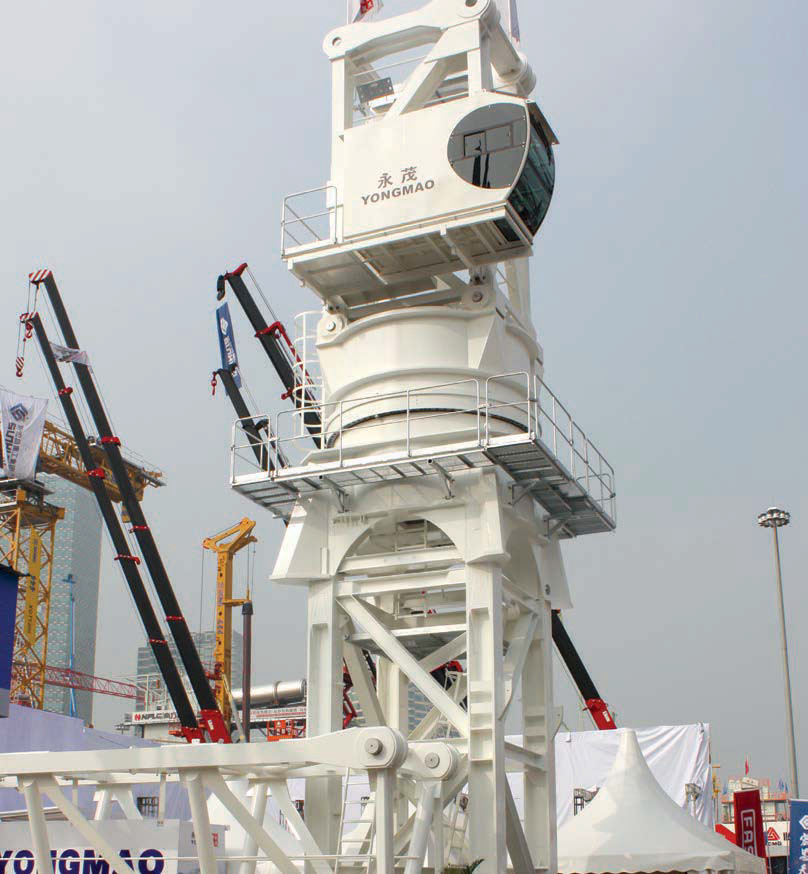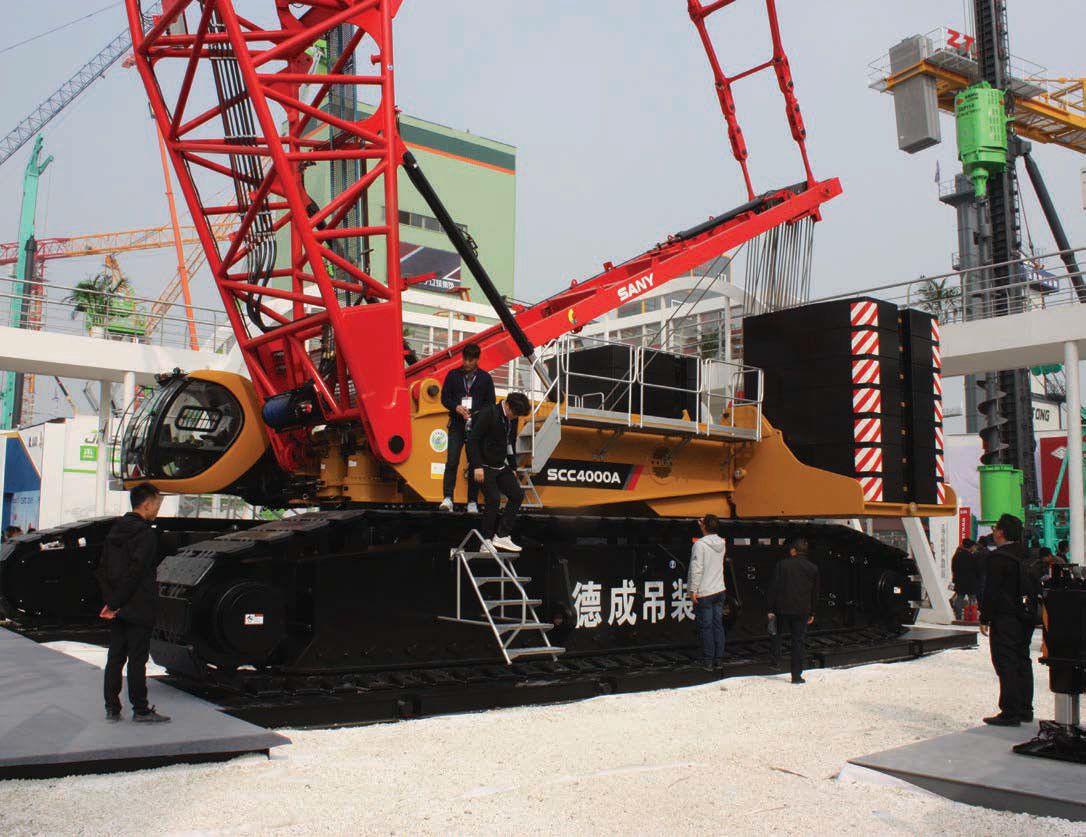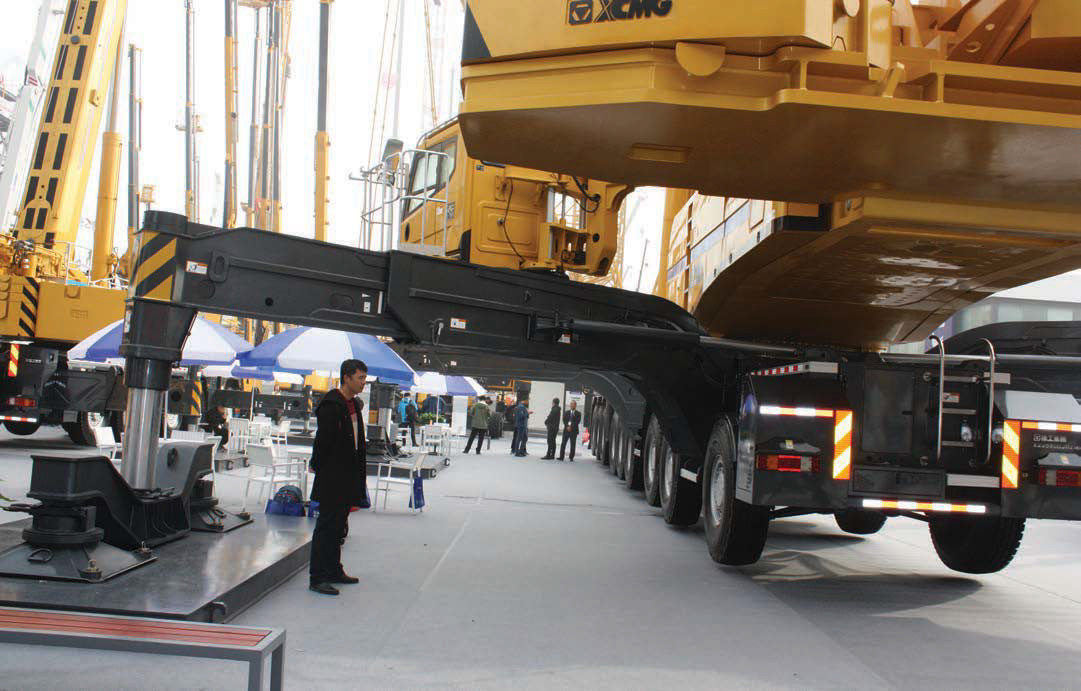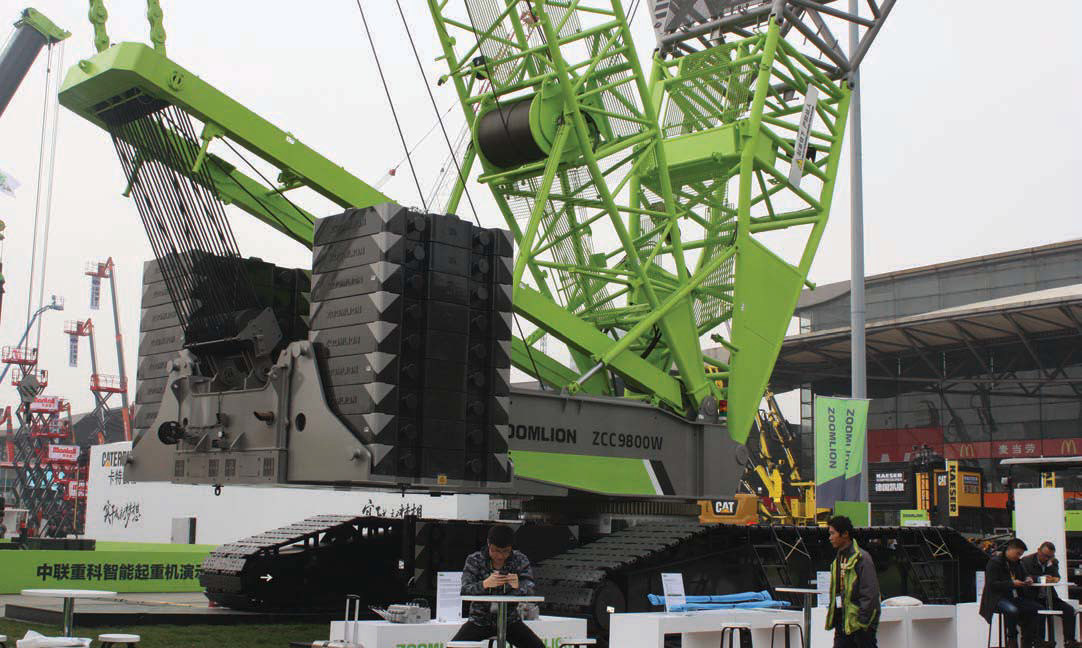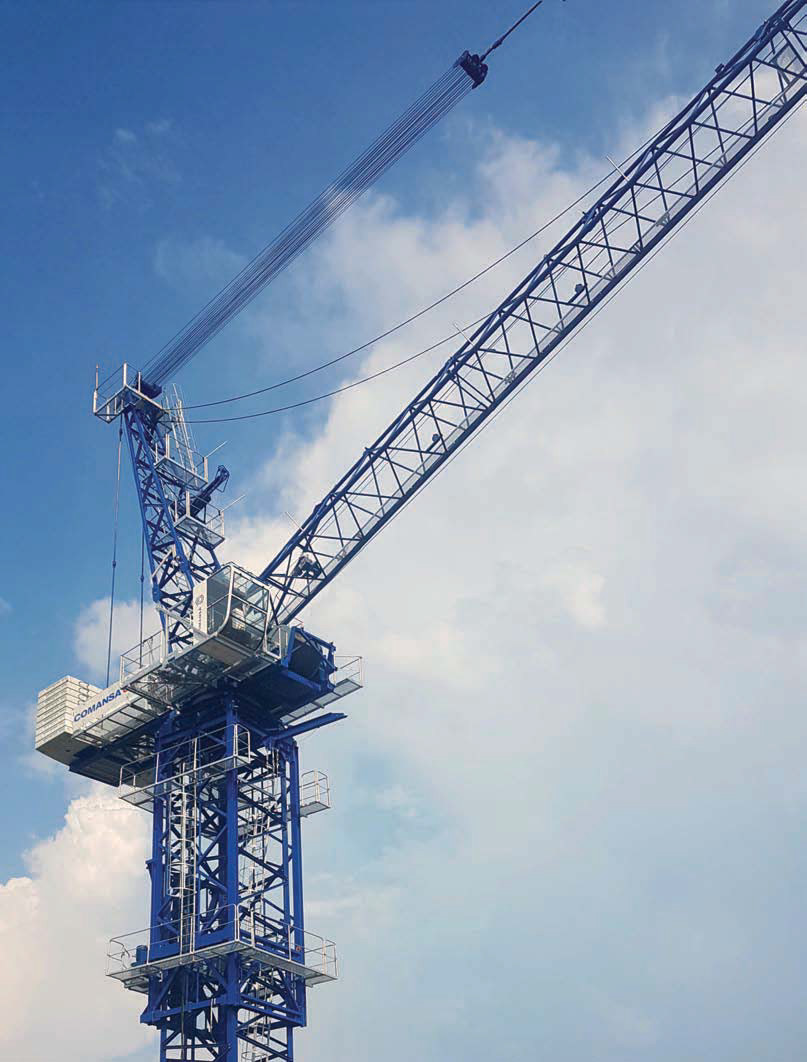Made in China
21 January 2019After some poor years for the crane market in China, government initiatives and a booming construction sector are focussing minds on global expansion. Julian Champkin reports.
China has been a focus for the global construction industry for decades. “China is the most important market in the world. It has huge potential for cities to grow. Those cities will need infrastructure, roads, sewerage systems.” So said Guangyu Nie, head of Liebherr parts division in Shanghai, in November 2018, reaffirming his company’s 40-years commitment to the Chinese market. He was speaking at Bauma China, the largest trade show for cranes and construction equipment in Asia.
There have been some slow years in the Chinese crane market recently. Now, though, business is booming. Bauma China was generally acknowledged as the busiest for several years, both for numbers of exhibitors and for numbers of visitors. And one thing became very clear there: that the pace of change within China is extraordinary.
“China is a unique place for us,” says Norbert Dudek, vice-president and general manager for Terex Cranes Asia. “I think it’s a unique place for anyone who manufactures cranes. 15 or 20 years ago, imported cranes—not just our cranes—made up around 70–75% of the cranes sold in China. Today the figure is around 5–7%. That is because the local manufacturing base has increased so dramatically.”
There are indeed dozens – perhaps hundreds – of Chinese manufacturers of cranes. Their reputation used to be as makers of cheap and cheerful cranes that bore more than a passing resemblance to Western models but whose quality was sometimes more than doubtful.
There were also the cranes made by joint venture operations between Chinese and Western manufacturers. It seemed a good business plan. The Chinese gained Western companies’ know-how and brand reputation; the Western companies hoped for lower labour costs and access to Eastern markets. Joint ventures have had mixed fortunes, however, not infrequently ending in acrimony or lawsuits. That may be coming to an end. The Chinese government has recently relaxed ownership laws, even in sensitive sectors like the automobile industry and construction; it is now possible for foreign concerns to own even 100% of a Chinese plant. “The era of joint ventures is over,” says Andreas Boehm, CEO of Liebherr International. The gain goes both ways: the stronger Chinese makers are no longer needing western brand reputation. “Among Chinese manufacturers, their own brands are being optimized now.”
There is still an “us” and “them” divide; but the “us” is now the quality manufacturers, whether Chinese or Western, whose offerings are a lifetime of reliability, full service, and aftersales backup; and the “them” are the low-cost makers who sell cranes and nothing else.
There are still some companies like that; but the major companies in China are now aspiring to be world players, or are world players already; and they recognise very well that to maintain that position they need reputations for reliability—and for aftersales service and support. The language of the top executives of the top companies at Bauma was hard to distinguish from that of top executives anywhere: they spoke of the soft power that comes from selling more than just a crane. Brand-building has come to China. But the Chinese company leaders have the added elements of confidence in rapid growth, both at home and in the export market, and of huge economies of scale, both domestically and which, with encouragement, can also be translated into the export market as well.
Consider XCMG. A state-owned company, it started in 1989. “We are currently ranked number six in world class machinery manufacturers,” says vice president Hu Xiangyang. “Now we are a global construction arm.” The company’s aim is to develop into a world class enterprise—and it is well on the way to that ambition.
“We are striving to reform innovation. Our industrial technology strategy is to move from the middle to the high end of the value chain. Only by innovation can we survive the technological upgrade of the industry. We will do so by using such things as Big Data, making our machines smarter, more energyefficient. Smarter equipment means a brighter future,” he says. XCMG makes tower cranes, telebooms and crawlers, but also construction and mining machines of all kinds. On display at Bauma was a driverless off-road dump truck, controllable remotely; in the not too distant future we may expect similar technology in their cranes. “High end is the end that we look for,” says Hu; “High added value, high reliability. Innovation is the key to the 21st century, and we hope to lead the market with innovative solutions.” Those who look on Chinese-made cranes as cheap and cheerful largely copying Western technology will be in for a rude shock.
Consider also Sany. In contrast to XCMG it is privately owned, founded 20 years ago by four university class-mates who still maintain day-to-day control. Now with 1,400 employees, its specialisations include tower cranes and hoists as well as construction machinery; but it strong as well in concrete, wind power, even banking and insurance.
“Most of China knows our brand” says Kim Lee, vice president for international business, who began his crane career at Terex. He is proud of the fact that Sany was the first manufacturing company in China to use robotic arms in manufacturing.
It is also a company that well sees the advantage of branding for added value. “Sany has manufactured big tower cranes for many years,” he says. “From the moment when we first entered the tower segment our philosophy was to add more value for the customer.”
For that reason they started big: they made large-capacity cranes. “We avoided price competition. There is more price pressure at smaller capacities. Sany’s market position is to be the premium supplier and to give premium solutions. So we started [in mobile cranes] by offering big capacities, of 100t and over. In crawlers, we have our 3,600t, which is a very big machine indeed.”
“A good enough product, a cheap price, but with no service or aftersales support. That is the image of some Chinese brands outside China. We do not want to follow this approach,” he says. “After many years of hard work, this high-end positioning of our products is now widely accepted by our customers. They understand the difference between Sany and other Chinese products.”
“In the past our sales people persuaded customers by saying “Our product is more expensive, but is much better.” But today I tell them to say “Our product is as good as a premium top brand, but we have a price advantage.” That should be our priority. Our benchmark is Liebherr, not Chinese brands.
“It took years of hard work to become accepted as a better brand; but this has now been achieved.
“We continue our focus on big tonnages; but we are strong enough now to focus on the smaller capacities also, because our quality is now acknowledged as better. So today our smallest crawler is 50t, our largest is 3,600t. Our market share is 43% across the range within China, so we dominate the market.” That, he says, is how Sany became number one in China.
We have mentioned the extraordinary pace of change in China. “Being very fast-growing is an advantage,” says Kim. Not least in the export market.
Sany’s ambitions are global. The company began exporting just ten years ago, in 2008. “In the UAE we are very advanced. In India we have been number one for many years. We have a big presence in Kuwait. Singapore is good for us, the middle east is best for us.” Sany claims to have captured 75% of the Kuwaiti market in just two years.
And despite the rapid pace of export advance, Sany’s planning is long-term. As witness its strategy for Europe and the US: “In Northern Europe we have a small market share, but it works for us,” says Kim. “I don’t think that we can overtake Liebherr in Europe, but then Liebherr has no chance of overtaking Sany in China!
“In the US we have had a presence for ten years. Our purpose there is not to have mass sales in the near future; it is to gain more understanding of the high-end market, of customer demands. We want to learn from them. At the moment we are there for learning. One day we will be there for more.”
A third major Chinese player is Zoomlion. They too are concentrating on intelligent digitisation in their machines.
“We cannot predict the future” says vice president Guo Xuehong, “but we can imagine what it can be like. And it will be about intelligent machines. So we are gradually upgrading our products and gradually improving them and creating new functions. We can give the operators machines that are simpler to operate, that make their work easier.”
And he, like vice president Hu of XCMG, can point to intelligent products that dispense with an operator altogether. “We have a 130t crane that users can control remotely. It can absolutely avoid dangers around it. It learns and manages the working scenarios. That makes work easier and safer. Now our machines have a brain and can think.
“Our main core continues to be studying new product fields. It is crucial that we see the changes and do the right thing to improve our palette,” he says. “We will keep creating new products that will feed the future: we will make future products for the future needs of our customers.”
You could call Sany, Zoomlion and XCMG the Big Three, though that is an oversimplification since there are other large and ambitious Chinese manufacturers. All of them increasingly are eyeing export markets. In this they are both implementing and being assisted by the Chinese Government strategic initiative known as ‘One Belt, One Road’ or nowadays more simply as Belt and Road. Broadly, the Belt is the construction of improved overland transport links to Europe and Asia; the Road is maritime links to India and Africa. China is planning on carrying out construction projects in more than 60 countries along these routes. Belt and Road has been varyingly described as a 21st century silk road or a marketing campaign for Chinese investment around the world. Since first announced by President Xi Jinping in 2013, some estimate that China has invested more than $210bn in the initiative to date, the majority of it in Asia, and that Chinese construction companies have secured contracts worth more than $340bn in contracts in the countries reached by it. The initiative is expected to cost more than $1tn (£760bn) by its completion date of 2045.
“Belt and Road is helping our sales,” says Kim of Sany. “We even have a vice-president in charge of it. Many projects inside China are local: when they are finished, they are finished. But Belt and Road is a foundation to build on. It looks outward to other countries, and leads to other projects in turn. Many Chinese companies are involved in it, and many of them are our clients. So we work with them. In China they love the service we give them; when they go abroad, they work with us also. In some countries they are new or have little presence; we can support them there because we do have a presence in those countries as we have been there for some years. It is win-win for both of us.”
Yongmao, a Chinese company making tower cranes, tells a similar tale. It is certainly export-minded: it says that around 50% of its production goes overseas. “We are trying to expand into Europe and the US,” says sales manager Jonas Tan. “We have a 64t flat-top working on the expansion of Helsinki airport. I think that may be the largest tower crane in Finland. Elsewhere in the world One Belt One Road has really helped. We and others have sold a lot of equipment for it. For instance, we have sold two 120t flat-top tower cranes for a power station in Indonesia.”
Western crane manufacturers with a presence in China are also noticing the effect of Belt and Road. Terex is one. “Over the last few years we have seen many changes, and one of the biggest is the Belt and Road initiative,” says Dudek. “Because what it actually does is that it facilitates a lot of our customers in China to go overseas. Over the past two years we have seen a real increase in crane customers venturing overseas, to a great extent in South-East Asia, but also to the Middle East. The Belt and Road initiative focuses Chinese minds on looking abroad. And the good thing for us is that we can really help them in that.
“Some of the issues crane owners would normally face, such as registering their machines overseas, or safety requirements which are very different than in China—we can assist them with that because our machines are already working in those countries and are safety qualified already; so they can bring their machines straight in and actually start getting on with the job.
“The other thing that is very important, more so even than the machine, is that we have the support structure. We can give the same seamless support overseas that we do in China. If a customer has one of our machines in China—it does not have to be a new machine, it might be one that is two or three years old—we will have serviced it and warranted it, and that information goes into a global system. So when the machine actually moves out, it might be to Saudi Arabia, to Kuwait, or anywhere in the world, our service technicians locally there already have the bill of health for it. There is no ramping up from the beginning; everybody will know what the machine is, when it was bought, its history, what have we done to it, any major issues it has had… So when the machine is operating outside of China the ‘hand-over’ really is seamless. This seamless process is giving our customers peace of mind when they go overseas.
“It is, after all, for many of them the first time they have operated outside China. It is traumatic; they just don’t know how to do it. We can be with them wherever they go. That is a distinct advantage we have over small local crane-makers and it really is a reassurance for crane owners.”
Liebherr is finding the same. “Belt and Road is giving outside contact to many more Chinese companies,” says Boehm. “One Belt One Road has meant that Chinese construction companies no longer view China in isolation,” says Eric Phua, sales director of the mobile and crawler division. “It is making Chinese companies go outside. They need someone to support them. We have presences already in the countries where they are going; so we can help them.”
A choice for Western companies is to manufacture in China, since labour costs and closeness to Asian markets are both strong arguments to do so, or to remain solely Europeor US-based manufacturers. Liebherr makes earthmovers and aircraft components in China; but it does not make cranes there, and has no plans to do so. It cites reputational reasons: “Quality for us is central to our brand,” says Phua “and German manufacture is known for quality. If we were to move out of Germany we would have to be sure that the savings would outweigh the costs. There is a lot of talk but we have a firm belief that to build in one location is better: the brand recognition must not suffer.”
Others square that circle. Comansa, for example, builds in China at its Hangzhou plant, and in Spain, and says that quality standards are uniform throughout. Some key components are best European brands sourced from Germany or Europe. Frequency inverter controls, for example, are from Germany, gearboxes are from Siemens’ Chinese facility, swing bearings are a German brand made in China, wire rope is European. Programme and setting functions are designed in the Spanish head office and modified for Chinese customer needs.
Belt and Road is affecting the crane sector, but it is benefitting primarily crawlers and telescopics rather than tower cranes like Comansa’s. But China is the largest market in the world for tower cranes. And another government initiative is causing their sales, also, to increase.
China is promoting prefabrication and pre-cast concrete sections for high-rise building. Components therefore are getting heavier. Tower cranes therefore need to be of larger capacity to lift them.
“Almost everyone in the tower crane business in China is thriving” says Tan of Yongmao. “The reason is the push to use precast sections to expedite production. A major problem is a lack of skilled workers in the construction industry.” That, and the need for speedy construction to keep pace with demand, is behind the government’s action. “So builders are now changing from smaller tower cranes to medium ones, of 18t – 20t capacity; because of this, tower cranes in China are booming.”
“The total volume of the tower cranes market in China is about CNY800m—that’s the domestic sales volume” says Comansa export manager Robin Hu. “Sales of tower cranes have more than doubled in the first three quarters of 2018 compared to the whole of 2017. For export, data runs for a different period, so is not directly comparable, but export sales – mainly to southeast Asian countries, including India and Australia, are also very good.
“And demand is for heavier loads. It used to be 5t–10t capacities that were most asked for. Now it is 25t–50t. There is much more prefabrication, and much more heavy steel in high-rise buildings. So market demand for tower luffing cranes is growing.”
It may therefore be no coincidence that two major western companies launched new tower cranes at Bauma Shanghai in November 2018. Manitowoc launched the Potain topless MCT565; and Comansa introduced two new luffers, the 24t CML310 and the 18t CML280. Both the Manitowoc and the Comansa offerings are made in China.
“We are expanding our factory in Hangzhou; we have acquired new land there to increase production capacity,” says Hu. Comansa are expecting to export the cranes to Thailand, Malaysia, Philippines, Vietnam, India. “Their market is all over south-east Asia, the Middle East and Africa,” says Hu.
The Chinese market is therefore curious mix of state guidance and free-wheeling enterprise, of state-owned companies and private ones, some home-grown, some western, of high quality and low, of huge domestic markets and equally-huge worldwide ambitions. Logical it might not be; but it is certainly alive and it is certainly going places.
